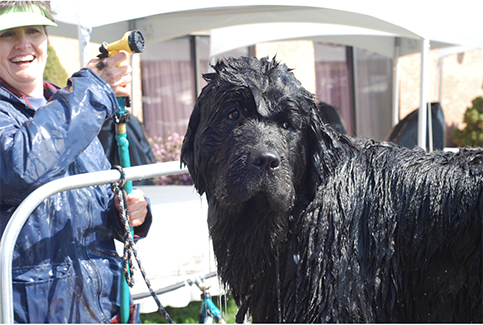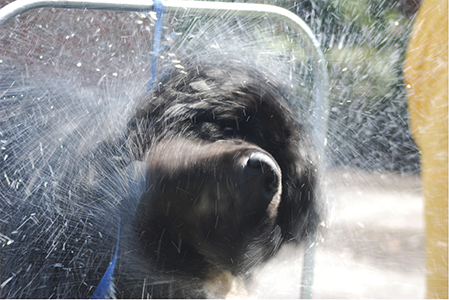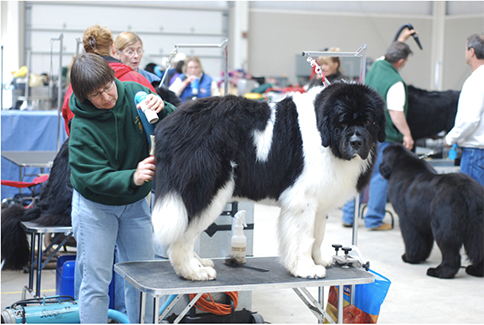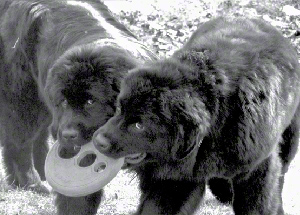A large, heavy-coated dog like a Newfoundland can be a challenge to bathe. Learn some tips from the experts on getting the job done right!
 The Lowdown on Dirty Dogs
The Lowdown on Dirty Dogs
Improper grooming causes many skin problems; in other words, a well-groomed dog is a healthy dog. Mats collect dirt and lead to hot spots, which smell. A matted dog is not pleasant to touch or live with.
Regular grooming will give you an early warning for fleas and ticks and reduce the amount of dog hair in the house. In addition, a well-groomed dog gets lots of attention when in public.
How Often Does My Dog Need a Bath?
Newfoundlands may be bathed as often as necessary, provided you use a good dog shampoo. Remember, when a dog is being shown, they are bathed once a week or more! We've found that Newfoundlands usually require more baths during the summer than the winter, with the heaviest grooming required during this period.
Bathing a dog is much easier if you have first combed the entire coat, removing all loose hair and mats. The two basic tools we use are a rake and a fine-tooth comb. The rake removes large clumps of hair while the fine-tooth comb "fine tunes" by removing any final loose hair.
Once your dog is combed out, you will find the bathing process easier.
1. To begin grooming, start with the rake. Push up the hair on the leg with your hand and comb down, pulling small amounts of hair at a time. By working up, you are starting with the shorter hair on the legs and pulling the longer body hair down. This way, you are always combing through already-combed hair.
2. If you come to a mat, hold the mat between your fingers, close to the skin (to minimize pulling) and comb through small amounts of the mat until you have worked the mat out. It seems as though mats always form behind the ears, under the front legs, inside the back legs and in the long hair on the front and back legs (furnishings). If you take long walks in the woods, check the furnishings often as they collect burrs and brambles.
Time for Suds: Apply Shampoo

1. Use a good quality shampoo. Mix your shampoo with warm water in a small container. We mix about 1/4 cup of shampoo to a quart of water.
2. Thoroughly wet the dog with warm water, starting at the head and working your way back.
3. Once the dog is wet, apply the shampoo in the same manner, starting at the head and working your way back and down. A small sponge works well to apply the shampoo.
4. If you tilt the dog's head back, you won't get shampoo in the eyes. You can use a sterile eye lubricant, available at any drug store, as protection for the eyes.
5. Work the shampoo in with your sponge, getting the suds all the way to the skin.
6. Don't forget to wash the bottom of the feet. The feet can collect all kinds of debris, which, if not removed, will cause problems.
You Can Never Rinse Too Much
Now that your dog is soaped head to toe to tail, it's time to rinse.
1. Again, tilt the head back and remove the shampoo the same way you applied it, from head to tail.
2. Rinse, rinse, rinse, rinse, then rinse some more. Any shampoo left on may cause skin irritations, itchiness and a greasy feel to the coat. Rinse until the water runs clean, then rinse again. Make sure you rinse under the tummy, under the front legs, and between the rear legs.
3. Stand back and let your dog have a few good shakes. If the dog's coat seems dry, we follow with a conditioning rinse by diluting it with water, working it into the coat (especially the furnishings), then rinsing again.
Dry To The Skin
There are many different techniques you may use to dry your dog. Towels will quickly remove most of the excess moisture, making the actual drying process easier. Dog "blasters", stand dryers, or a canister-type vacuum with the hose plugged into the exhaust port all work, but a blaster will be most efficient . As you dry, comb through the dog again, removing any hair the bath has worked loose. When the dog is dry, give him a big hug and a cookie, and tell him how pretty he looks (and how wet he made you!).


